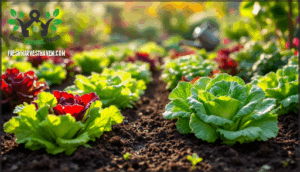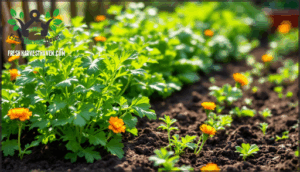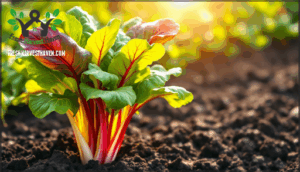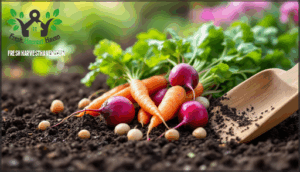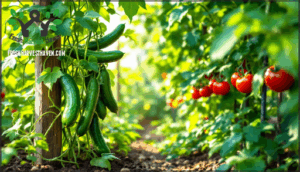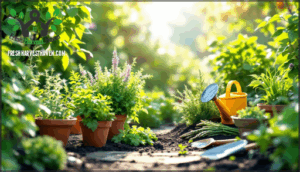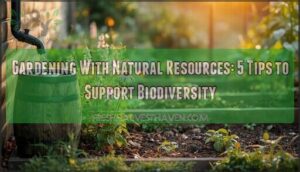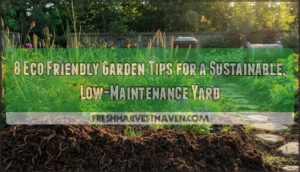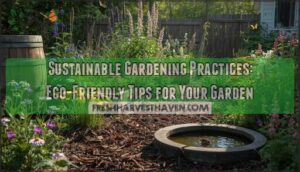This site is supported by our readers. We may earn a commission, at no cost to you, if you purchase through links.

The truth is simpler: certain vegetables practically grow themselves in spring’s cool weather, delivering harvests in weeks rather than months. Leafy greens like lettuce and spinach mature in 30 to 45 days. Root vegetables such as radishes pop from soil in just 20 to 30 days. Even fruiting crops like beans and tomatoes succeed with minimal fuss when timed right.
If you’ve hesitated to garden because you feared failure, these easy vegetables to grow in spring are exactly where you should start—they’re forgiving, fast, and genuinely rewarding.
Table Of Contents
- Key Takeaways
- Easiest Leafy Greens for Spring Gardens
- Simple Root Vegetables to Plant in Spring
- Low-Maintenance Fruiting and Vining Crops
- Beginner-Friendly Herbs and Perennial Vegetables
- Top 10 Easy Spring Vegetable Products
- 1. Hydroponic Lettuce Seedling Mix Pack
- 2. bok choy plants for garden
- 3. Red Yellow Onion Garden Sets
- 4. organic green onion heirloom seeds
- 5. organic cherry belle radish seeds
- 6. Live Asparagus Bare Root Plants
- 7. Live Artichoke Plant in Gallon Pot
- 8. Green Bell Pepper Live Plants
- 9. Big Boy Tomato Live Plants
- 10. chard plants ready to plant
- Frequently Asked Questions (FAQs)
- What soil temperature is best for spring planting?
- How often should I water spring vegetables?
- When can I start planting after winter?
- What tools do I need for spring gardening?
- How do I protect crops from late frosts?
- How do I know when soil is ready for spring planting?
- Should I start seeds indoors or direct sow outside?
- What pests commonly attack spring gardens and how do I prevent them?
- Conclusion
Key Takeaways
- Spring’s cool weather naturally favors fast-growing crops like lettuce (30-45 days), radishes (20-30 days), and spinach (40-45 days), making them ideal starter vegetables for beginner gardeners who want quick, forgiving harvests.
- Success with spring vegetables depends on proper timing—plant cool-season crops like peas and greens 4-8 weeks before the last frost, but wait until soil reaches 55-70°F for warm-season crops like tomatoes, beans, and cucumbers.
- Root vegetables like carrots, beets, and turnips require loose, well-draining soil worked 6 inches deep with compost to prevent forking and ensure straight growth, while consistent watering prevents cracking and woody texture.
- Succession planting every 2-3 weeks extends your harvest window throughout spring, particularly effective for fast-maturing crops like lettuce, arugula, and radishes that can bolt in heat.
Easiest Leafy Greens for Spring Gardens
Leafy greens are your secret weapon for spring gardening—they grow fast, don’t demand much, and give you harvests in weeks instead of months. Whether you’re looking for tender lettuce leaves, nutrient-packed spinach, or something with a little more flavor and flair, there’s a green that fits your garden and your timeline.
Here’s what works best when the weather is cool and the days are getting longer.
Growing Lettuce for Quick Harvests
When spring arrives, lettuce becomes your fastest route to garden success. Leaf lettuce varieties reach harvest in just 30 to 45 days, and you’ll start picking tender leaves even sooner if you want baby greens. The secret? Lettuce loves cool weather between 60 and 65 degrees—exactly what spring offers.
Start seeds two to four weeks before your last frost date, spacing plants about one foot apart in loose soil with a pH between 6.0 and 6.7. Water consistently, since lettuce needs steady moisture to stay crisp and prevent bitterness. Incorporating compost improves growing conditions for lettuce, regardless of soil type.
Here’s where succession planting transforms your harvest: sow new lettuce seeds every two to three weeks for non-stop salads through spring. Pick outer leaves in the morning before the heat rises, and your plants keep producing. Store harvested lettuce in the cold for two to three weeks.
- Baby leaves ready in four weeks—your salad bowl fills faster than frustration sets in
- Cool weather champion—lettuce thrives when spring frosts still threaten tender crops
- Continuous harvests—sow every two weeks for steady greens through the entire season
Spinach: Early Spring Planting Tips
Spinach thrives when you plant it early—about 4 to 8 weeks before your last frost date, when soil temperatures hit 45°F. Direct sow seeds half an inch deep, spacing them 2 inches apart in loose, well-draining soil with a pH between 6.5 and 7.5. Once seedlings reach 2 inches tall, thin them to 4 to 6 inches apart so each plant gets room to grow.
Spinach benefits from fertile, well-drained soils rich in organic matter. Use row covers for frost protection and keep soil consistently moist—dry conditions trigger bolting and bitter leaves.
This cool-season crop reaches harvest in 40 to 45 days, giving you tender greens before spring heat arrives.
Fast-Growing Arugula and Kale
Once spinach’s cool window closes, arugula and kale pick up where it left off. Arugula germinates in just 2-7 days and reaches harvest in 20-40 days, giving you tender, peppery leaves before summer heat triggers bolting. Kale takes longer—50-70 days—but produces nutrient-dense greens for months.
Both thrive in full sun and loose, well-draining soil (pH 6.0-7.5). Direct sow arugula every 2-3 weeks for continuous harvests. Thin seedlings to proper spacing, keep soil consistently moist, and consider companion planting with marigolds to reduce pest pressure by up to 40%.
Swiss Chard Care and Harvesting
Where arugula and kale thrive through late spring, Swiss chard steps in as your reliable green machine. This leafy powerhouse fares well in cool weather and doesn’t demand fussy soil prep—just work in a few inches of compost before planting.
Space seeds 6 inches apart in early spring, keeping soil consistently moist with about 1 to 1.5 inches of water weekly. Best conditions include full sun and well-draining soil with a pH between 6.0 and 6.8.
In 60 days, start harvesting outer leaves, leaving the crown intact so your plant keeps producing. Varieties like Bright Lights add color while staying simple to maintain. With minimal nutrient management needed in rich soil, chard delivers continuous harvests straight through spring.
Simple Root Vegetables to Plant in Spring
Root vegetables are some of the most rewarding crops to plant in spring because they’re forgiving, fast-growing, and thrive in cool soil. Whether you’re looking for radishes that mature in just a few weeks or carrots and beets that give you reliable harvests, these underground growers pack a lot of value into small garden spaces.
Let’s walk through the best root vegetables to plant right now and how to get them growing.
Radishes: Fastest Spring Crop
Want to skip the long wait? Radishes mature in just 20-30 days—the speediest spring crop you can grow. These germination champions need loose, sandy soil with full sun and consistent moisture (about 1 inch weekly). Direct seed half-inch deep after your last frost date, spacing seeds 1 inch apart in rows 4-6 inches apart.
Radish varieties like Cherry Belle and French Breakfast thrive in cool weather. Interplant them with slower crops—they’ll finish before competing for nutrients. Their quick turnaround makes succession planting smart: sow new batches every two weeks for continuous harvests through spring.
Here’s your radish success plan:
- Prepare loose soil by removing rocks and debris to prevent forking
- Sow seeds directly in early spring for faster germination in 3-10 days
- Water consistently to avoid woodiness and get crisp roots
- Harvest at 3-5 weeks when roots reach pencil thickness for best flavor
Carrot and Beet Planting Basics
Carrots and beets demand patience, but they reward you with sweet, earthy flavors worth the wait. These cool-season root vegetables thrive in spring’s moderate temperatures and become garden treasures.
Success starts with soil preparation and consistent care:
- Soil Preparation: Work compost into loose, sandy soil 6 inches deep to prevent forking and promote straight roots
- Seed Spacing: Sow carrot seeds ½ inch deep, 18–20 per foot of row; thin beets to one plant every 3 inches for proper sizing
- Germination Times: Expect carrots to germinate in 14–21 days; beets sprout faster in 7–10 days with soil temperatures between 45–85°F
- Nutrient Needs: Apply 1 cup of 10-10-10 fertilizer per 10 feet of row before planting; avoid excess nitrogen, which stunts root development
- Temperature Effects: Carrots mature best near 75°F days and 55°F nights; growth slows above 85°F, producing woody, discolored roots
Maintain uniform moisture throughout the season to prevent cracking. Both crops mature in 60–80 days, rewarding your early spring planting with harvests before summer heat arrives.
Turnips and Bunching Onions for Beginners
When spring arrives, turnips and bunching onions offer beginner gardeners foolproof success. Turnips reach harvestable size in just 45–60 days, while bunching onions mature in 8–10 weeks, both thriving in cool weather.
Turnips should be started with seeds planted ½ inch deep, spaced 1 inch apart in rich, well-drained soil with at least 6 hours of sunlight. Thin seedlings to 2–4 inches apart for proper root development. Bunching onions prefer sandy soil with a neutral to slightly acidic pH (6.0–7.0) and should be sown every 2–3 weeks for a continuous harvest. Water consistently to prevent splitting and disease.
Both crops resist common pests better than other vegetables, though crop rotation prevents soil-borne diseases. Harvest turnips at 2–3 inches in diameter; pick bunching onions when stems reach pencil thickness.
| Crop | Days to Harvest | Spacing | Pest Resistance |
|---|---|---|---|
| Turnips | 45–60 | Thin to 2–4" | Good; rotate crops |
| Bunching Onions | 8–10 weeks | 4" apart | Less susceptible to onion maggots |
| Turnip Greens | 35–40 | Thin seedlings | Excellent dual harvest |
Low-Maintenance Fruiting and Vining Crops
Once you’ve mastered the basics with leafy greens and root vegetables, you’re ready to try crops that give you more bang for your effort. Fruiting and vining vegetables like beans, cucumbers, and tomatoes deliver abundant harvests without demanding constant attention.
Here’s what works best for spring gardeners looking to expand their success.
Green Beans: Minimal Effort, High Yield
Green beans are your shortcut to gardening success. They thrive in soil temperatures above 55°F and air temps between 65–85°F, producing a full harvest in just 50–65 days. Direct sow seeds after frost passes, and you’ll get tender pods without fussing. Bush varieties need no support; pole beans climb on their own.
These warm-season crops pack 13% daily fiber and are loaded with calcium and potassium. Disease-resistant varieties mean fewer problems, while smart water management boosts nutrient content.
Whether you’re planning your first garden or expanding an existing bed, green beans deliver reliable yields with minimal effort.
Easy Cucumbers and Zucchini
Cucumbers and zucchini are heat-loving powerhouses that thrive in full sun and loose, well-draining soil. These warm-season stars need soil temperatures between 70°F and 90°F to germinate properly, so wait until frost danger has passed before planting.
Here’s what sets them up for success:
- Space zucchini plants 24–36 inches apart to boost air circulation and cut fungal disease risk by up to 40%
- Install sturdy trellises or fencing for vining cucumber varieties to improve yields by 30% through better light exposure
- Water consistently—uneven watering stresses plants and increases bitterness in cucumbers
- Harvest every 1–2 days to encourage continued fruiting and extend production by 2–3 weeks
Both crops mature in 50–60 days, delivering abundant harvests. A single zucchini plant produces 10–20 fruits per season under ideal conditions, while healthy cucumber plants yield 5–10 pounds. Regular harvesting prevents seeding and keeps plants productive longer.
Tomatoes and Peas for Spring Success
Tomatoes and peas are spring garden superstars, but they need smart timing to thrive. Start tomato seeds indoors five weeks before your last frost date—cherry varieties mature in 50–60 days, while larger types need 65–85 days. Direct-sow peas four weeks before frost when soil hits 40°F; they’ll germinate reliably at high rates and produce abundant yields with proper spacing.
| Crop | Soil Temp | Days to Maturity | Yield per 30-ft Row |
|---|---|---|---|
| Cherry Tomato | 77°F best | 50–60 days | 200–300 lbs |
| Slicing Tomato | 77°F best | 65–85 days | 400–500 lbs |
| Snap Pea | 40°F minimum | 55–70 days | 47–54 lbs |
| Snow Pea | 40°F minimum | 60–75 days | 44–67 lbs |
Both crops demand well-draining soil with pH 6.0–7.0 and consistent moisture. Space peas 7–8 plants per square foot for maximum disease resistance and productivity. Harvest regularly—it keeps plants producing longer and stronger.
Beginner-Friendly Herbs and Perennial Vegetables
Herbs and perennial vegetables are your secret weapons for extending the growing season and adding flavor to your kitchen. Unlike annuals that need replanting each year, many of these options come back year after year or establish themselves quickly from seed.
Let’s look at the best choices for spring planting that’ll give you reliable harvests with minimal fuss.
Basil, Dill, and Parsley Essentials
For fresh flavor without fuss, basil, dill, and parsley thrive in your spring garden. Basil germinates around 70°F and reaches harvest in 60 to 70 days—give it six hours of direct sunlight daily and consistent soil moisture. Dill matures usually faster, in 40 to 60 days, though heat speeds bolting. Parsley takes longer, 70 to 80 days, but tolerates cool temperatures well.
All three prefer well-drained soil with a pH between 6.0 and 7.0.
Harvest before flowering to lock in peak flavor, then refrigerate basil for a week or store parsley cool and humid for months.
Growing Asparagus and Artichokes in Spring
If you’re ready to think long-term, asparagus and artichokes reward your patience. Plant asparagus crowns 6 to 8 inches deep in early spring when the soil is workable—this depth minimizes weeds and strengthens spears. Aim for a soil pH between 6.0 and 7.5.
Artichokes need cool exposure below 50°F for flowering to trigger, so early spring planting works perfectly. Both thrive in full sun with consistent watering. Space asparagus 1 to 1.5 feet apart.
Expect minimal harvests in the first year, but established beds yield steadily for 12 to 15 years with proper nitrogen fertilization and drainage.
Top 10 Easy Spring Vegetable Products
Now that you’ve chosen your spring vegetables, the right products make all the difference. Whether you’re starting from seeds or giving yourself a head start with seedlings and live plants, we’ve rounded up ten reliable options that’ll set you up for success.
Here’s what works best for getting your garden growing this spring.
1. Hydroponic Lettuce Seedling Mix Pack

Hydroponic lettuce seedling mix packs transform spring gardening with speed and reliability. You’ll receive approximately 500 seeds across 12 varieties—butterhead, romaine, and loose leaf types—engineered for hydroponic nutrient solutions. With germination rates consistently hitting 85%, seedlings emerge within 2-3 days under ideal conditions (60-75°F water temperature).
Here’s what makes these packs ideal for spring:
- Fast biomass accumulation — 35-40% quicker growth than soil methods due to constant nutrient availability
- Predictable timing — full heads ready in 4-5 weeks, perfect for staggered spring plantings
- Economic viability — higher yields per cycle reduce your cost-per-harvest considerably
- Low energy consumption — efficient nutrient uptake means less wasted resources
Perfect for beginners seeking reliable spring harvests.
2. bok choy plants for garden
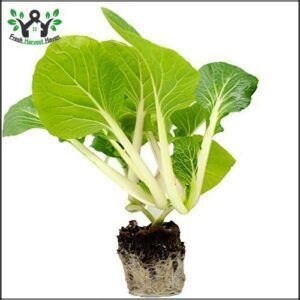
Once you’ve got your hydroponic lettuce started, bok choy plants bring reliable success to spring container gardening. These compact Asian greens mature in 30-45 days under ideal conditions of 55-75°F and 6 hours of daily sunlight. Plant them 7 inches apart in fertile, well-drained soil (pH 6.0-7.5) with consistent moisture to prevent bolting. Their natural pest resistance and 90% transplant success rate make them perfect for beginners. You’ll harvest tender baby leaves in weeks or full-sized plants by late spring—all while enjoying impressive economic yields and outstanding nutrition.
| Feature | Details | Your Benefit |
|---|---|---|
| Harvest Time | 30-45 days | Multiple spring plantings |
| Nutrition | 95% vitamin A, 71% vitamin C | Nutrient-dense meals |
| Pest Resistance | Natural defense, 30% less pesticide need | Easier, safer growing |
3. Red Yellow Onion Garden Sets
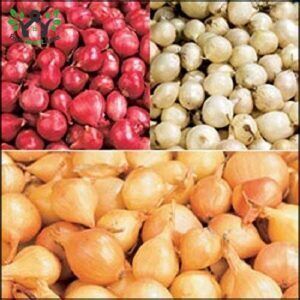
Two onion varieties give you reliable spring success: red and yellow sets mature in 85–120 days. Plant them pointed-end up, ¾–1 inch deep once soil reaches 48°F, spacing them 4–6 inches apart. You’ll harvest 20–25 pounds per 10-foot row. Spanish Yellow matures fastest (80–100 days), while reds store wonderfully after curing. Both thrive in well-drained soil (pH 6.0–6.8) with consistent moisture and full sun.
- Fastest yellow varieties reach maturity in under 100 days
- Excellent storage life through proper 2–3 week curing at 25–30°C
- Pest-resistant cultivars like ‘Cabernet’ reduce fungal disease by 35–50%
- Heavy feeder advantage—nitrogen side-dressing boosts bulb firmness by 10–20%
- Cold-tolerant bulbs plant earlier than seed-grown onions for spring wins
4. organic green onion heirloom seeds
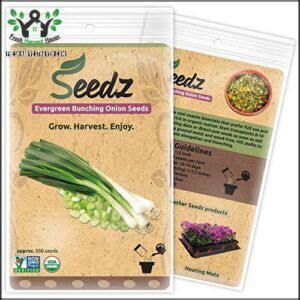
Organic heirloom green onion seeds bring reliable spring success to any beginner’s garden. These USDA-certified organic seeds germinate reliably within 10–14 days once soil warms to 60°F or above.
You’ll harvest tender scallions in roughly 65 days, and here’s the best part—you can keep harvesting the green tops continuously once plants reach 4 inches tall.
Their cold-hardy nature survives down to -30°F, making them perfect perennial additions to your spring beds. With about 9,500 seeds per ounce, you’re getting great value for sustainable gardening success.
5. organic cherry belle radish seeds

If you’ve ever planted something and wanted results yesterday, Cherry Belle radishes are your answer. These heirloom seeds germinate within 4–6 days and deliver marble-sized roots ready to harvest in just 22 days—perfect for spring planting.
Here’s what makes them excellent for beginners:
- Fast germination at 55–75°F with consistently moist soil
- Simple spacing at ½ inch deep, 2–3 inches apart
- Crisp, peppery-sweet flavor under full sun exposure
- 250 seeds per packet for succession planting every two weeks
- Continuous harvests throughout cool spring weather
Plant them 4–6 weeks before your last frost. Loose, well-drained soil with a pH between 6.0 and 7.0 ensures uniform root development and prevents splitting. Succession plant every 10–14 days for ongoing harvests.
6. Live Asparagus Bare Root Plants
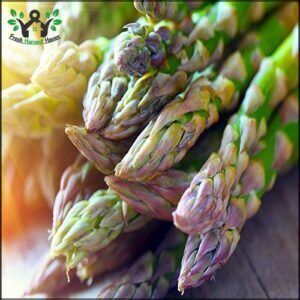
Asparagus bare root plants deliver homegrown spears faster than you’d expect. While you’ll wait until year three for full harvests, these dormant crowns establish strong roots when planted 6–10 inches deep in well-drained soil with a pH between 6.5 and 7.5.
Position them in full sun—they need at least eight hours daily—and space crowns 12–18 inches apart. Apply phosphorus fertilizer to boost early root development, then add four inches of mulch to suppress weeds and retain moisture.
Once established, these perennial vegetables produce for 12–15 years, yielding up to 20 spears per crown annually. Spring planting sets you up for decades of easy harvests.
7. Live Artichoke Plant in Gallon Pot

Artichoke plants in gallon pots give you a head start on gourmet harvests. After your last spring frost, transplant them into full sun—they need 6–8 hours daily—spacing plants 3–4 feet apart in well-draining soil with a pH between 6.0 and 7.0.
Water deeply once or twice weekly, providing about 1 inch per week. The 24–36 inch container size accommodates their extensive root systems, and regular mulching retains moisture while regulating temperature.
Watch for aphids and slugs; neem oil works well for pest control. Each plant produces 6–9 edible buds within 85–100 days. With proper perennial care and annual pruning, your potted artichokes yield harvests for 3–5 years.
8. Green Bell Pepper Live Plants
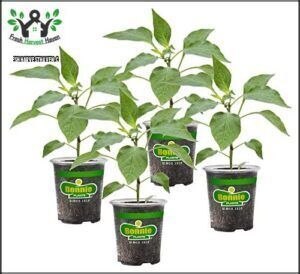
Want peppers that actually produce? Green bell pepper plants deliver 5–10 sweet peppers per plant in just 45–55 days once warm weather hits. Plant them 18–24 inches apart in full sun after soil reaches 60°F.
They’ll progress through growth stages quickly—from vegetative growth through flowering to fruiting—yielding about 3.7 pounds of crisp peppers perfect for stuffing or slicing. Stick with balanced 5-10-10 fertilizer to support healthy fruiting without excess leafy growth.
Space them well and water consistently; staking becomes necessary as fruit loads increase. Expect disease-resistant varieties that thrive in spring’s warming temperatures, transforming your garden into a productive harvest machine.
9. Big Boy Tomato Live Plants
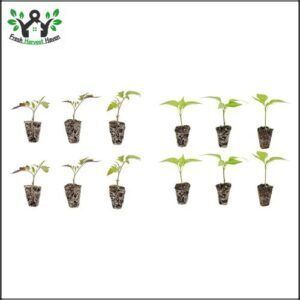
Big Boy tomatoes are indeterminate growers that produce massive 16–32 ounce fruits continuously over a 10-week harvest window. Plant them 18–36 inches apart in full sun after your last frost date, spacing deeper than pot level to encourage strong roots. These plants stretch 6–10 feet tall, so sturdy cages or stakes are non-negotiable for support.
Water consistently—about 1 inch weekly—to prevent fruit-cracking and blossom-end rot. Expect your first ripe tomatoes around 78 days after transplanting, with yields reaching up to 100 tomatoes per plant under favorable conditions.
While not specifically bred for disease resistance, proper pruning of lower foliage and drip irrigation help minimize fungal issues. Apply balanced fertilizer like 5-10-5 to support healthy fruit production throughout the season.
10. chard plants ready to plant
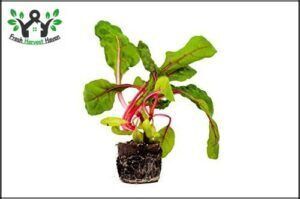
Ready-to-plant Swiss chard seedlings skip the germination guesswork and get you harvesting in just 35–40 days. These professionally grown transplants arrive 4–6 inches tall with established root systems, ready for immediate garden placement.
For best results, transplant them outdoors between mid-March and early April in cold-winter zones, or January through March in milder climates. Space plants 12–18 inches apart in soil with a pH between 6.0–6.8, enriched with compost and nitrogen-rich organic matter.
Swiss chard tolerates partial shade but thrives with 6–8 hours of sunlight daily. Water consistently and expect continuous "cut-and-come-again" harvests throughout spring and early summer.
Many varieties like Bright Lights offer colorful stems that make your leafy greens garden both productive and visually striking.
Frequently Asked Questions (FAQs)
What soil temperature is best for spring planting?
Most spring vegetables germinate best between 55–70°F, though cool-season crops like lettuce and spinach tolerate 45–55°F. Warm-season plants need 65–75°F.
Measuring soil temperature helps you time planting right, avoiding cold soil rot and warm soil bolting that damage yields.
How often should I water spring vegetables?
Like a gardener’s intuition, your watering schedule shifts with the seasons. Most vegetables need about one to two inches weekly, but soil type matters—clay holds moisture longer than sandy soil, which drains fast.
Check soil one inch deep; water when dry. Young plants need frequent watering until established, while mature plants in hot weather may need deep soaking twice weekly.
Morning watering reduces evaporation and disease risk.
When can I start planting after winter?
Your last frost date marks the turning point. Plant cool-season crops—spinach, lettuce, peas—six to eight weeks before it arrives. Wait until after frost danger passes for warm-season vegetables like tomatoes, cucumbers, and beans.
Check your hardiness zone to find your specific frost date and soil temperature thresholds for successful germination.
What tools do I need for spring gardening?
You might think you need fancy equipment to start gardening, but that’s not true. A few quality hand tools will get you growing. Grab a shovel and garden fork for soil preparation, a rake for bed work, a trowel for transplanting, and pruning shears for harvesting.
For watering, a simple garden hose beats lugging buckets. Ergonomic tools reduce strain on your hands and back—worth the investment. Budget $20–$30 per tool for durability that lasts seasons.
How do I protect crops from late frosts?
Protect tender crops when temperatures drop below 35°F. Cover plants with frost blankets or row covers—they trap ground heat and raise temperatures 2–5°F. Water soil beforehand; moist earth holds warmth better.
For extra protection, use sprinkler irrigation, which releases heat as water freezes. Remove covers once temperatures climb to prevent overheating.
How do I know when soil is ready for spring planting?
You’ll know your garden soil is ready when soil temperature reaches at least 40°F, moisture content passes the squeeze test—soil crumbles but holds briefly—and there’s no compaction risk from working wet ground after the last frost date.
Should I start seeds indoors or direct sow outside?
It depends on the vegetable. Indoor seed starting boosts germination rates above 90% and permits earlier harvests, but direct sowing develops stronger roots and avoids transplant shock—especially for beans, carrots, and radishes.
What pests commonly attack spring gardens and how do I prevent them?
Ironically, your spring garden’s biggest enemies arrive just when everything starts thriving. Aphids, flea beetles, and cabbage worms top the list of common spring pests.
You can prevent damage using cultural pest control like crop rotation, physical barriers such as row covers, and biological controls including beneficial pollinators and predatory insects for organic gardening success.
Conclusion
Picture your garden six weeks from now: crisp lettuce leaves catching morning dew, radishes pushing through dark soil, rows of green beans climbing their stakes. That vision starts today with these easy vegetables to grow in spring.
Choose three varieties from this list, plant them this weekend, and you’ll harvest real food before summer arrives. Your first successful garden isn’t about doing everything—it’s about starting with crops that want to succeed as much as you do.

